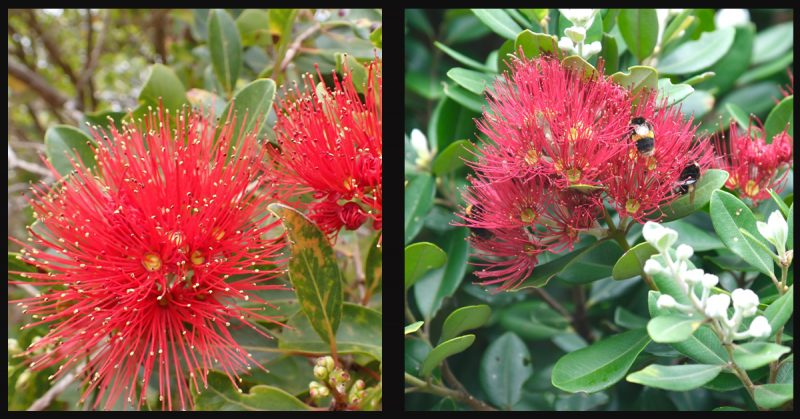Ulu Kanu: Metrosideros

Why Metrosideros?
Because this newsletter features an article about a trip to Aotearoa and a talk story with two Kiwi, it seems only fitting that our plant (or plants) of the month should have a New Zealand connection as well. We love our ‘ōhi‘a lehua (Metrosideros polymorpha). Its Maori cousin, the pohutukawa (Metrosideros excelsa), gets just as much love from our ‘ohana across the Pacific.
More About Them
Metrosideros are part of the Myrtaceae family and are trees or shrubs, sometimes epiphytic, or root-climbing lianas. We have five species of Metrosideros here in Hawai‘i: ‘ōhi‘a lehua (polymorpha), lehua mamo (macropus), lehua ‘ahihi (tremuloides), lehua papa (rugosa), and Metrosideros waialeale. Metrosideros polymorpha, with “polymorpha” meaning “many forms”, exhibits a wide morphological and ecological range. There are eight recognized varieties of polymorpha in Hawai‘i. There are also a wide variety of Hawaiian names that can be used for all of the species listed above, so the ones used in this article are just for simplicity.
Our ‘ōhi‘a can range in color from almost white (a pure white flower is fabled but has never been formally documented) to orange, yellow, pink, red, and various shades in-between. There are flowers that have been known to be multi-colored or change color after a few days of flowering. There are even trees that have different colored blossoms on them. What we see as flowers are actually a group of flowers with long stamens and pistils. They bloom sporadically and all year round. They are a favorite food of our native honeycreepers such as ‘i’iwi and ‘apapane and are used in honey making today. Mixtures of flowers and hau with water were given to women in labor when their childbirth pains were intense. The flowers have always been a favorite lei material, although usage has dropped off somewhat due to worries about ROD. The name Metrosideros refers to the very hard wood of these plants, and the wood can be used for kapa making tools, musical instruments, and more.
There are twelve species of Metrosideros in Aotearoa. There are two pohutukawa (mainland and Kermadec), and ten rata, including six vines, three trees, and a shrub. The flowers of the pohutukawa bloom around Christmas time and can be seen lining the coasts with a beautiful red. Before it became New Zealand’s Christmas tree, it was already well known from Maori stories. One story talks of a small, wind-beaten tree near Cape Reinga that is said to guard the entrance to a sacred cave through which spirits pass on their way to the next world.
ROD and Rust
ROD disease in Hawai‘i is due to two fungal pathogens- Ceratocystis lukuohia and Ceratocystis huliohia. Crowns of affected trees turn yellowish and then brown within days to weeks. Trees within a given stand appear to die in a haphazard pattern, but other plant species are not affected by the disease. In dead trees, the presence of the fungus is always accompanied by dark radial staining in the outer ring of the cut trunk.
Myrtle rust (Austropuccinia psidii) is a wind-borne fungal disease that infects plants in the myrtle family in Aotearoa. The disease causes bright yellow-orange powdery pustules on young leaves, shoots, fruits, and flowers of the plants. Infection can cause deformation, twig dieback, and may result in plant death.
These diseases are extremely difficult to eradicate. However, we can help prevent the spread by avoiding injuring plants, not transporting them, cleaning gear and tools used around them, and washing tires and the undercarriage of vehicles with any soil or mud gathered from use in the forest. It is also important to report any cases you may see to the proper authorities.
How To Grow It
First off, ensure that you know the condition of the plant and have permission (e.g. permits) to use the seeds or cuttings from a plant.
Seed- The tiny seeds are contained in a capsule that turns brown as seeds mature. Collect the mature capsules before they split open. Put them in a paper bag or envelope and keep them dry. The dust-like seeds that eventually fall out will germinate at low light levels but may prefer bright light. Sow the seeds on the surface of a moist, sterile potting medium at a temperature between 72 and 93 degrees. Keep the medium moist and place the seed containers in a covered, shady location to control moisture and reduce rain damage. The seeds should germinate in about 10 days, but be aware that only about 20% of the seeds are actually viable in any given capsule.
Cutting- Use tip or stem cuttings that are about 1/4 inch in diameter and 4 to 6 inches long. Remove portions of the leaves on the upper part of the cutting. A rooting medium in low concentration should be used. You can grow the plants in a pot inside if desired. If the intention is to grow them outside, make sure to transfer the plants before they become root-bound, as that will stunt their growth for a while.
Metrosideros are relatively easy to grow given good sunlight, rich organic soil, and excellent drainage. Just be sure to dig a hole that is not too deep, about twice as large as the root ball, and with good drainage at the bottom. The roots of the plant should be planted as is, and soil should not cover the surface area around the trunk base. Although ‘ōhi‘a can grow quickly, they do not develop a canopy until after many years and can tolerate some crowding from companion plants such as koa and ‘iliahi. If required, light pruning can be done, but be careful not to over prune at any one time.
Sources
https://cms.ctahr.hawaii.edu/rod/
https://www.doc.govt.nz/nature/native-plants/pohutukawa/
https://www2.hawaii.edu/~eherring/hawnprop/met-poly.htm
http://nativeplants.hawaii.edu/plant/view/Metrosideros_polymorpha/
Wagner, Warren L., Herbst, Derral R. and Sohmer, S.H.. Manual of the Flowering Plants of Hawai‘i, University of Hawaii Press, 1990.


